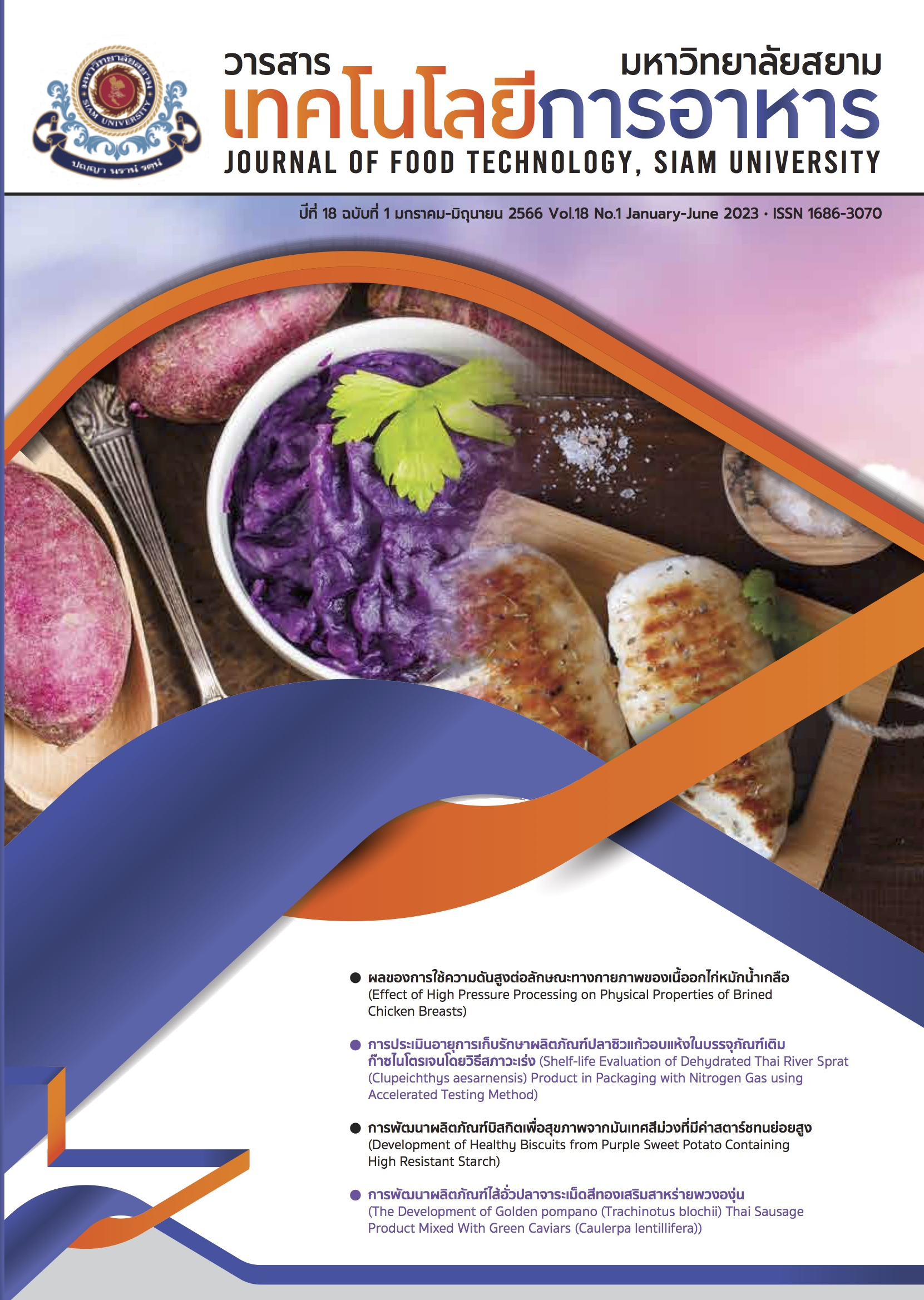Effect of High Pressure Processing on Physical Properties of Brined Chicken Breasts
Main Article Content
Abstract
High Pressure Processing (HPP) is a promising way to tenderize meat. HPP treatment at 100, 200 and 300 MPa for 10 min was employed to study 10% and 20% brined chicken breasts (RTC meats), thereafter HPP pasteurization treatment at 90±2 °C for 20 min (RTE meats). The results showed that pressure treatment above 200 MPa induced significantly (p≤0.05) the RTC meat texture for 10% brine with harder but higher springiness than 20% brine. The chewiness showed higher in 10% brine than 20% brine at 300 MPa. Meat color was significantly effected (p≤0.05) by HPP at 300 MPa with increasing L* value for both 10% and 20% RTC meats. The redness (a*) value only affected RTE meats for 10% and 20% RTE when the pressure increased to 200 and 300 MPa. A significant (p≤0.05) increase was found in 10% and 20% RTC meats when treated with 300 MPa.
Article Details

This work is licensed under a Creative Commons Attribution-NonCommercial-NoDerivatives 4.0 International License.
Copyrights of all articles in the Journal of Food Technology available in print or online are owned by Siam University and protected by law.
References
Temgire, S., Borah, A., Kumthekar, S. and Idate, A. (2021). Recent trends in ready to eat/cook food products: A review. The Pharma Innovation Journal. 10(5): 211-217.
O'Neill, C., Cruz-Romero, M.C., Geraldine, D. and Kerry, J.P. (2019). Comparative effect of different cooking methods on the physicochemical and sensory characteristics of high pressure processed marinated pork chops. Innovative Food Science and Emerging Technologies. 54(8): 19-27.
Cavitt, L. C., Meullenet, J. F. C., Xiong, R. and Owens, C. M. (2005). The relationship of razor blade shear, allo-kramer shear, warner-bratzler shear and sensory tests to changes in tenderness of broiler breast fillets. Journal of Muscle Food. 16(3): 223-242.
Ashie, I. N. A., Sorensen, T. L. and Nielsen, P. M. (2002). Effects of papain and a microbial enzyme on meat proteins and beef tenderness. Journal of Food Science. 67(6): 2138-2142.
Kim, H-Y., Kim, K-J., Lee, J-W., Kim, G-W., Choe, J-H., Kim, H-W., Yoon, Y. and Kim, C-J. (2015). Quality characteristics of marinated chicken breast as influenced by the methods of mechanical processing. Korean Journal for Food Science of Animal Resources. 35(1): 101-107.
Xiong, Y.L. (2005). Role of myofibrillar proteins in water-binding in brine-enhanced meats. Food Research International. 38(3): 281-287.
Bowker, B.C., Callahan, J.A. and Solomon, M.B. (2010). Effects of hydrodynamic pressure processing on the marination and meat quality of turkey breasts. Poultry Science. 89(8): 1744-1749.
Bharti, S.K., Anita, B., Das, S. K. and Biswas, S. (2011). Effect of vacuum tumbling time on physico-chemical, microbiological and sensory properties of chicken tikka. Journal of Stored Products and Postharvest Research. 2(7): 139-147.
Huang, H-W., Hsu, C-P. and Wang, C-Y. (2020). Healthy expectations of high hydrostatic pressure treatment in food processing industry. Journal of Food and Drug Analysis. 28(1): 1-13.
Dong, K., Luo, X., Liu, L., An, F., Tang, D., Fu, L., Teng, H., and Qun, H. (2021). Effect of high pressure treatment on the quality of prepared chicken breast. International Journal of Food Science & Technology. 56(4): 1597-1607.
Yaldagard, M., Mortazavi, S.S. and Tabatabaie, F. (2008). The principles of ultra high pressure technology and its application in food processing/preservation: A review of microbiological and quality aspects. African Journal of Biotechnology. 7(16): 2739-2767.
Radovčić, N. M., Ježek, D., Markov, K., Frece, J., Curic, D. and Medić, H. (2020). The effect of high pressure treatment on the quality of chicken breast meat. Croatian Journal of Food Technology, Biotechnology and Nutrition. 14(3-4): 76-81.
Guo, T., Xue, S., Zou, Y., Han, M., Xu, X. and Zhou, G. (2015). Effect of sodium chloride on the properties of ready-to-eat pressure-induced gel-type chicken meat products. Journal of Food Process Engineering. 40(1): 1-11.
Ramirez-Suarez, J. C. and Morrissey, M. T. (2006). Effect of high pressure processing (HPP) on shelf life of albacore tuna (Thunnus alalunga) minced muscle. Innovative Food Science & Emerging Technologies. 7(1): 19-27.
Kruk, Z. A., Yun, H., Rutley, D. L., Lee, E. J., Kim, Y. J. and Control, C. J. J. F. (2011). The effect of high pressure on microbial population, meat quality and sensory characteristics of chicken breast fillet. Food Control. 22(1): 6-12.
Carlez, A., Veciana-Nogues, T. and Cheftel, J.C. (1995). Changes in colour and myoglobin of minced beef meat due to high pressure processing. Lebensmittel-Wissenschaft & Technologie. 28(5): 528-538.
Bak, K. H., Bolumar, T., Karlsson, A. H., Lindahl, G. and Orlien, V. (2019). Effect of high pressure treatment on the color of fresh and processed meats: a review. Critical Reviews in Food Science and Nutrition. 59(2): 228-252.
Zhuang, H. and Browker, B. (2016). Effect of marination on lightness of broiler breast fillets varies with raw meat color attributes. LWT- Food Science and Technology. 69(7): 233-235.
Smith, D. P. and Young, L. L. (2007). Marination pressure and phosphate effects on broiler breast fillet yield, tenderness, and color. Poultry Science. 86(12): 2666-2670.
Sazonova, S., Galoburda, R. and Gramatina, I. (2017). Effect of high pressure processing on microbial load in pork. Research for Rural Development. 1: 238-243.
Utama, D.T, Lee, S.G, Baek, K. H, Chung, W. S, Chung, I. A, Jeon, J. T. and Lee, S. K. (2017). High pressure processing for dark-firm-dry beef: effect on physical properties and oxidative deterioration during refrigerated storage. Asian-Australasian Journal of Animal Sciences. 30(3): 424-431.


